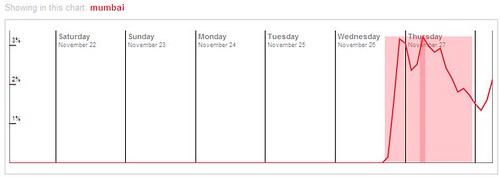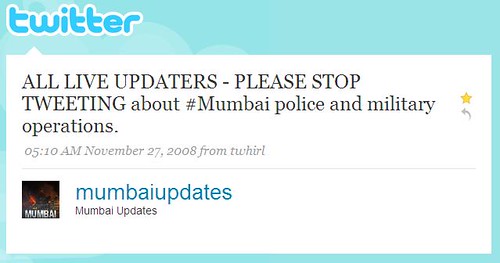I followed the events in Mumbai yesterday with one eye on CNN and one eye on Twitter. It was both fascinating and horryfying to follow the stream of short reports from people on the ground in India, complemented by comments from fellow twitterers from around the world. I use a service called TweetDeck to follow Twitter and during most of the day yesterday the program flashed about 20-30 new tweets about Mumbai at a time (posted to the channel #mumbai), several times a minute, and it still does. Some estimated that there were 80 messages posted about the events every five seconds. The graph below shows the huge volume (I counted more than 5,000 tweets during the latter part of yesterday) of tweets about Mumbai during the last days.
Many eyewitness reports also came on for example blogs and photo sharing sites like Flickr. Blogs like Mumbai Help aggregated news reports and important phone numbers. And 27-year-old Vinukumar Rangnathan posted more than a hundred photos on Flickr which were viewed hundreds of thousands of times by people around the world. Some of them were even used by media outlets such as CNN.
“I have been getting mails from several news channels and websites who wanted to host my pictures. I agreed,” he said.
A search for photos tagged with “Mumbai” can be found here.
While there are many benefits of this kind of citizen reporting, one should also use them with caution. A lot of rumours are circulating and this morning I noticed two tweets following right after each other were the first said that there were probably no ties to Al-Qaida, the second said the ties to Al-Qaida had now been confirmed. At one point yesterday, many messages on Twitter suddenly reported that the Indian government had asked people to stop tweeting about military operations in the area. The source of these rumours seemed to be a message from Twitter user Mumbaiupdates.
Blogger Amy Gahran decided to try to track the source of this widely reported rumour and found out that the person behind the twitter account was not actually in Mumbai, but a high school junior based in Boston named Mark Bao. In an email to Garhan he explains the origins of his post.
“The rumour started on via another twitter post that retweeted from another person that was a trusted source IN mumbai. Later, it was confirmed on video that the police wanted live updates of the operations to be stopped, though they did not mention the hashtag #Mumbai, though they asked media outlets to stop reporting live.
The purpose of [the MumbaiUpdates] stream was to disseminate info from the CNN-IBN, NDTV and those twittering from Mumbai. With any news reporting and re-reporting it’s possible errors got in the way. I’m sorry if it caused any confusion.
If anything, even if NDTV and CNN-IBN were still reporting, it is best practice, and I think justified, to stop tweeting and disseminate more information on the operation that could be spread and could be useful to those that we don’t want to let know the info.”
So there is still no evidence that any Indian authorities have demanded that people should stop tweeting about specific stories in Mumbai. Read Amy Gahran’s full post, it is quite interesting.
More about the role of social media in the terrorist attacks in Mumbai can be found here:
– Journalism.co.uk
– India eNews
– Ohsohightech (in Swedish)
– Same Same but Different (in Swedish)

